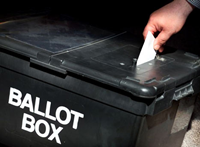Council Election - Voting System Explained
Inverclyde’s Returning Officer for May’s local government elections says it is vital that voters make sure they know how to cast their votes on polling day.

Local council elections in Scotland use the Single Transferable Vote (STV) system. Councillors are elected in multi-member wards where voters rank the candidates in order of preference.
Returning Officer and Inverclyde Council Chief Executive Aubrey Fawcett said:
“Always read the instructions for filling in the ballot paper carefully, even if you have voted before. The ballot paper lists the name of each candidate, whether they are an independent, or if they are representing a political party with that party name, party logo and in every case their address.
“Rank the candidates in order of preference. Put a 1 next to your first-choice candidate, a 2 next to your second-choice, a 3 next to your third-choice, and so on. You can rank as few or as many candidates as you like.
“If you make a mistake then you should tell polling staff who can issue you a replacement ballot paper provided you have not placed your vote in the ballot box.”
Unlike the more well-known first-past-the-post system, candidates do not need a majority or more votes than their competitors to be elected – just a known share, or quota.
The votes are counted in stages. During the first stage only the first preferences are counted and anyone who reaches the agreed quota is elected.
Any votes that are left over are then transferred to the second preference and if not enough candidates hit the quota, the one with the lowest number of votes is eliminated and all their votes are passed to the next preference on the ballot papers.
The process is repeated until all the candidates are elected for the number of Councillors in that ward.
Aubrey Fawcett added: “It is extremely important that people check their poll cards for the election carefully. It will confirm whether you have to vote in person, or whether you have a postal vote, a proxy vote, or a postal proxy vote. The poll card will also confirm your local polling place if you are voting in person.
Please check the details on the poll card carefully as there have recently been a significant number of changes to ward and polling district boundaries, meaning your polling place may have changed since you last voted.”
On Thursday 4 May 2017 there will be elections to all 32 councils in Scotland. In Inverclyde 22 councillors will be elected to serve in 7 wards.
To be able to vote you must be registered in the council area where the election is taking place and must be aged at least 16 on polling day, a British, Irish, EU or qualifying citizen.
Full details can be found by following the link on this page.